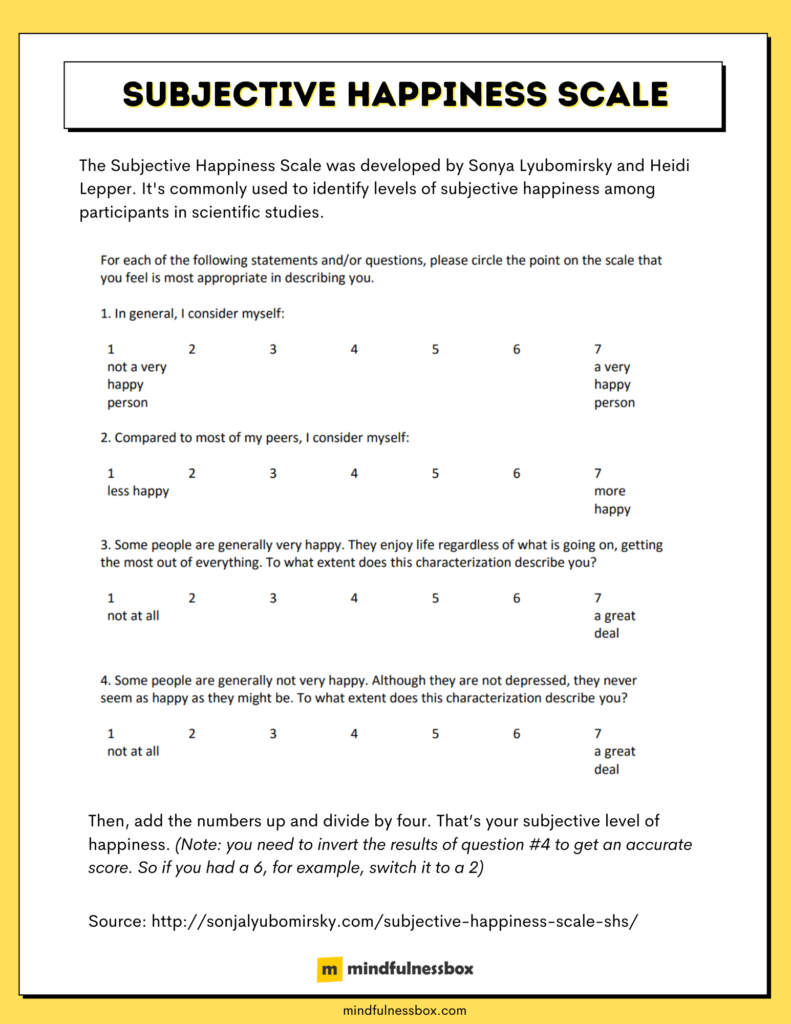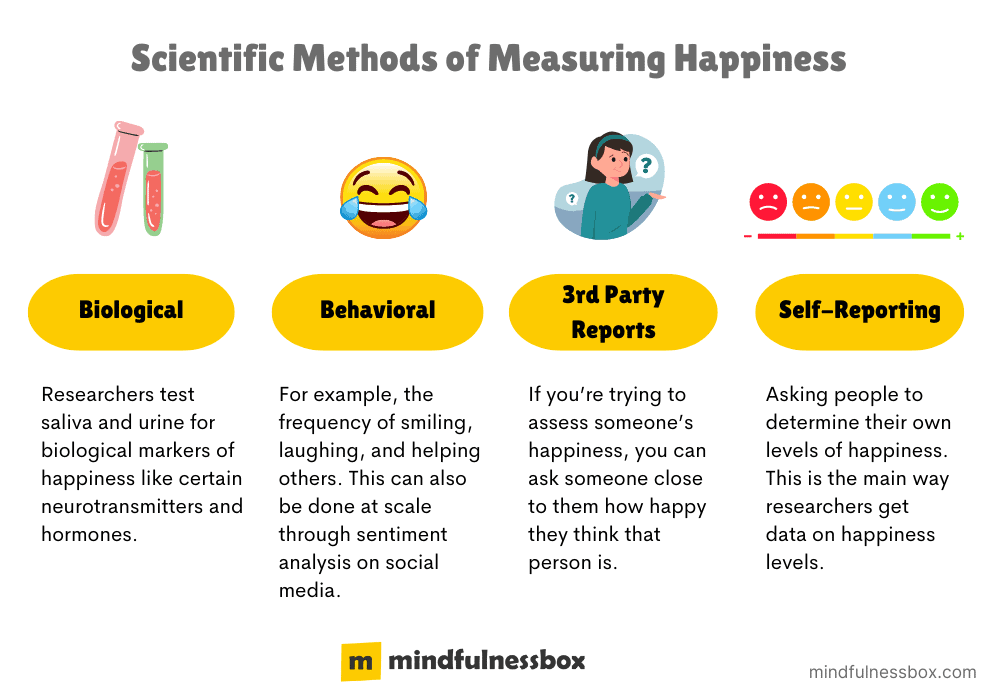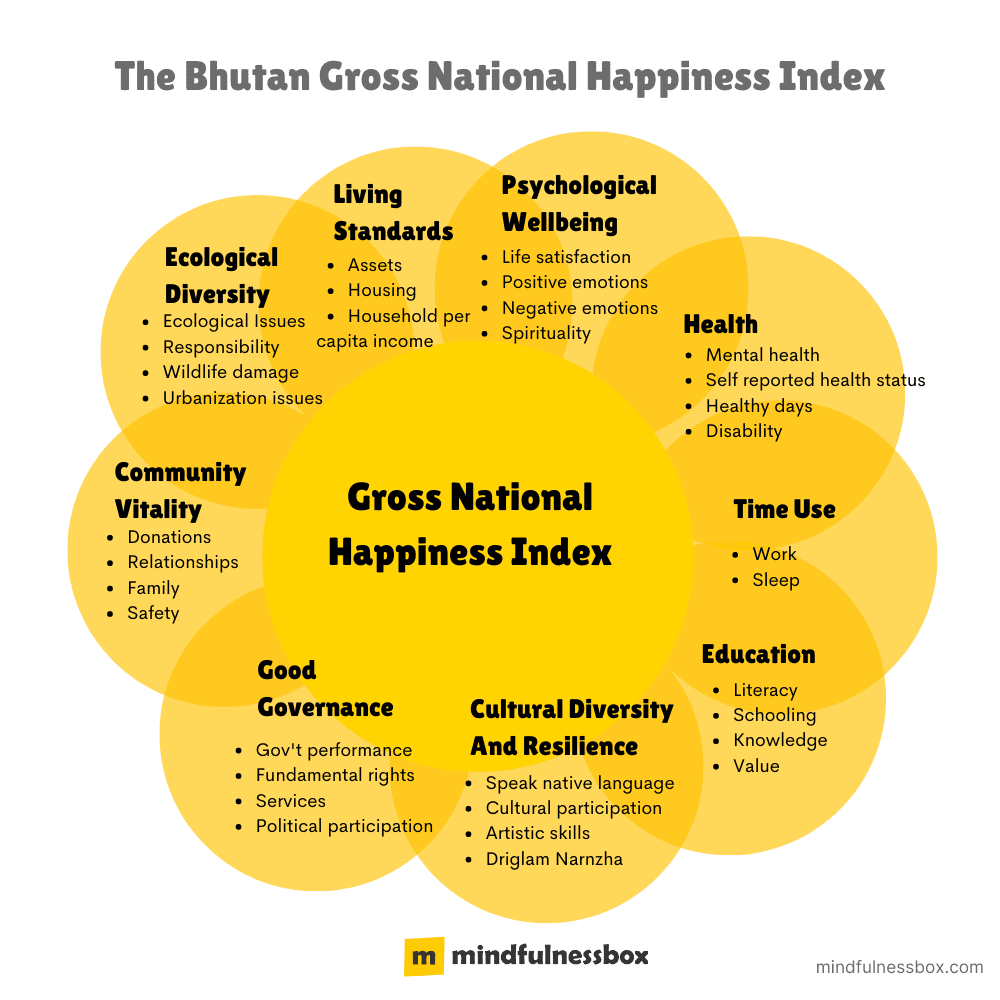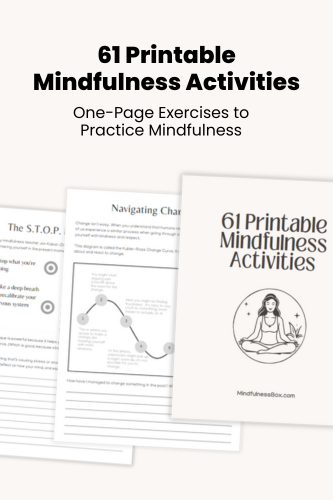Happiness is subjective. But measuring happiness can be done using the subjective happiness scale, which you can also use to track your own happiness over time. Some studies also use behavioral observations and biological data to determine happiness. Measuring data by country requires using bigger picture metrics like life expectancy and per capita GDP.
Each year, the UN World Happiness Report comes out with a list of the happiest countries in the world. (Usually, the Scandinavian countries win).
But running happiness surveys isn’t as simple as it might seem.
Get dozens of one-page exercises to help practice mindfulness, meditation, gratitude, and self love. Perfect for printable handouts when teaching mindfulness to groups, students, or in the workplace.
To see examples, plus a full list of the 61 exercises included, click below.
From self-reported surveys, to sentiment analysis, to testing saliva for oxytocin, there are a variety of ways to measure happiness.
Perhaps an even bigger question is “What’s worth measuring in the first place?”
Life satisfaction, meaning, and positive emotions all play a role in happiness. And the results of happiness surveys can vary dramatically depending on which is prioritized.
Let’s explore the different ways to measure happiness, critiques of the current methods, and even how you can measure your own happiness.
Can happiness be measured?

Yes. Happiness can be measured using self-reported subjective happiness levels, behavioral observations, and biological data.
Measuring happiness at the collective level (like for a country) requires zooming out and using big picture data.
The UN World Happiness Report, for example, uses these variables: levels of GDP, life expectancy, generosity, social support, freedom, and corruption.
There’s also a technique called “sentiment analysis” which uses artificial intelligence to pull data that might indicate positive or negative sentiment across an entire region. For example, Twitter posts and Google searches can be used to point towards possible increases or declines in happiness on a country-wide or global level.
Happiness studies at the individual level are most commonly completed using self-reported surveys. Participants choose options like “very happy,” “quite happy,” “not very happy,” and “not at all happy.” If you’re looking to measure your own happiness, this is also something you can do on your own
Some happiness studies seek to measure happiness scientifically, as explored below.
The Subjective Happiness Scale

Want to measure your own happiness? The Subjective Happiness Scale is a time-tested way to do this.
Measuring your own happiness can be a helpful way to see trends in your moods. And research shows the simple act of measuring your happiness may (on its own) improve your happiness, as long as you get feedback on what to keep improving.
Here’s how to get started.
First, find a mood tracking app and start tracking how you feel.
A journal works too, but apps are nice because they can automatically create charts to show you trends over time.
Second, identify your baseline level of happiness.
The Subjective Happiness Scale was developed by Sonya Lyubomirsky and Heidi Lepper. It’s commonly used to identify levels of subjective happiness among participants in scientific studies. You can take it yourself!
The questions are simple (rate yourself 1-7 on each):
- In general, I consider myself:
(a) not a very happy person or (b) a very happy person - Compared to most of my peers, I consider myself:
(a) less happy or (b) more happy - Some people are generally very happy. They enjoy life regardless of what is going on, getting the most out of everything. To what extent does this characterization describe you?
(a) not at all (b) a great deal - Some people are generally not very happy. Although they are not depressed, they never seem as happy as they might be. To what extent does this characterization describe you?
(a) not at all (b) a great deal
Then, add the numbers up and divide by four. That’s your subjective level of happiness.
(Note: you need to invert the results of question #4 to get an accurate score. So if you had a 6, for example, switch it to a 2)
You may want to record this in your mood tracking app so you can see if it changes upon taking the test again in the future.
How to measure happiness

Measuring happiness is still by and large the domain of psychology and social science.
Biological markers for happiness, like neurotransmitters and hormones, are being explored but aren’t yet particularly helpful in determining happiness and life satisfaction.
Part of the issue is that hormones like oxytocin, while associated with happiness, can fluctuate wildly based on what you’ve done recently.
So while increased oxytocin levels might indicate that playing with your dog for 60 minutes brings you happiness, that data is less useful for understanding your overall well-being.
Dr. Mark Holder leads a happiness research team at the University of British Columbia. In an article for Psychology Today, he describes a number of methods for measuring happiness.
- Biological: Researchers test saliva and urine for biological markers of happiness like certain neurotransmitters and hormones. The science on this is still developing.
- Behavioral: Behavioral scientists have explored measuring happiness through the frequency of smiling, laughing, and helping others. This can also be done at scale through sentiment analysis on social media.
- Third party reports: If you’re trying to assess someone’s happiness, you can ask someone close to them how happy they think that person is. In addition to self-reported happiness data and biological and behavioral traits, this can provide a fuller picture.
- Self-reporting: Asking people to determine their own levels of happiness. This is the main way researchers get data on happiness levels.
How is happiness measured in economics?

Measuring the happiness levels of entire countries is a different undertaking than measuring the happiness of an individual.
The UN World Happiness Report has attempted to do this since 2012 by measuring the following factors in over 150 countries:
- Real GDP per capita
- Social support
- Healthy life expectancy
- Freedom to make life choices
- Generosity
- Perceptions of corruption
For 2021, the happiest countries were Finland, Denmark, Switzerland, Iceland, and the Netherlands.
The Bhutan Gross National Happiness Index takes a different approach.
The Bhutan Gross National Happiness Index

The small country of Bhutan has gauged its level of national happiness for a couple decades now. Every five years, survey-takers head out across the country to interview 1% or so of the country’s population of 800,000.
Its methodology is different from the UN World Happiness report.
Instead of GDP and life expectancy, Bhutan’s GNH measures:
- Psychological Well-being
- Material Well-being
- Good Governance
- Health
- Education
- Community Vitality
- Cultural Diversity and Resilience
- Balanced Time Use
- Ecological Diversity
The questions are more personal than you might find on an equivalent UN Happiness survey.
Common questions include:
- Do you meditate?
- How frequently do you pray?
- How much time and money do you devote to your community?
- How many hours do you sleep?
- How many hours do you work?
- How often do you quarrel with your family?
- Do you trust your neighbors?
Can you measure your own happiness?

Yes. You can measure your own happiness over time through journaling or smartphone apps.
You can also identify your baseline level of happiness by completing the Subjective Happiness Scale or a similar measure of well-being.
I’ve used the app Journey.cloud to measure my moods over time.
During the good times, it feels gratifying to see how consistently happy you’ve been. Tracking your happiness can help you start to self-identify as a happier person.
During the difficult times, it’s helpful to go back in time to remind yourself that fluctuations in your mood are normal. It’s happened before, and although sometimes it feels permanent, it’s always temporary.
Happiness might increase when you measure it

In fact, the simple act of measuring your happiness may itself increase your happiness.
One study found that simply measuring happiness (and getting feedback on those measurements) might increase your levels of happiness.
In 2020, a three month study was conducted with 22 participants using a smart watch that measured happiness, activity levels, and stress.
All participants entered data into the smart watch daily, but only the experimental group received regular happiness feedback about the data they’d entered. For example, they might receive feedback on which activities made them happier or unhappier.
The participants who recorded their happiness levels (and got feedback on the data they entered) saw their levels of happiness increase 16% more than the control group.
Based on this study, recording your levels of happiness and then talking them over with a friend or counselor may be an effective way to boost your happiness levels.
Critiques of happiness measurement methodology
We still don’t have a perfect way to measure happiness.
Global surveys on happiness track data that provides the conditions for happiness, but doesn’t necessarily mean people are happier in those countries.
For example, Finland has often topped the UN World Happiness Survey, which is dominated by questions around life satisfaction, values, and social factors.
However, Finnish well-being expert Frank Martela argues that this is only one way to measure happiness.
When you measure happiness instead by how much positive emotion people experience, Latin American countries like Costa Rica, Guatemala, and Paraguay show up as the happiest.
When you measure happiness by whether people feel meaning in their lives, African countries like Togo and Senegal are at the top.
Martela also points out that Finland has relatively high rates of depression when compared with other developed countries:
“If happiness is the prevalence of positive emotions (let alone the displaying of them), Finland is not the happiest country. If happiness is the absence of depression, Finland is not the happiest country. But if happiness is about a quiet satisfaction with one’s life conditions, then Finland, along with other Nordic countries, might very well be the best place to live.”
Start measuring your happiness today
If you’re curious about your levels of happiness, there’s no harm in measuring them. And doing so may even help you nudge your levels of happiness up.
Start by getting a baseline reading of your current happiness levels using the subjective happiness scale.
Then, track your happiness over time. See if you can notice any trends in what’s making you happy, and what isn’t.
For more on happiness, you may be interested in the following articles:
- How to Increase Your Happiness Set Point
- How to Increase Your Vibrational Frequency
- What Makes A Good Life?
- How to Appreciate Life

My mindfulness practice kicked off in 2016 with a ten-day silent retreat. Since then, I’ve read dozens of books about mindfulness and completed hundreds of hours of meditation. Thinking about what makes humans happy, calm, and peaceful is endlessly fascinating to me.


